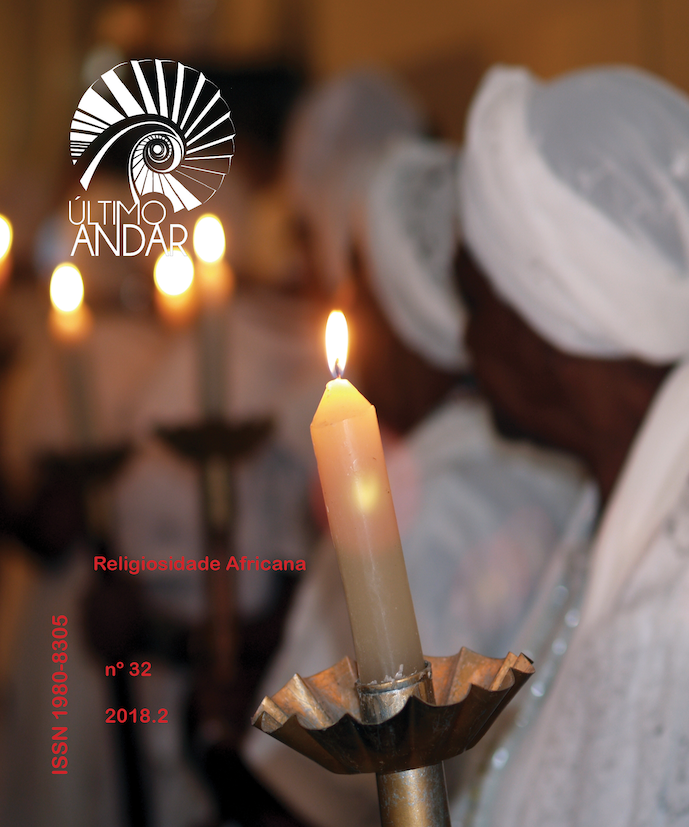PRÁTICAS RELIGIOSAS E FESTIVAS NAS ESCOLAS DE SAMBA DE SÃO PAULO: UM ESTUDO SOBRE O CANDOMBLÉ NA VAI-VAI
DOI:
https://doi.org/10.23925/1980-8305.2018i2p33-43Palavras-chave:
Religiões afro-brasileiras, escola de samba, Candomblé.Resumo
Este artigo aborda um aspecto do carnaval brasileiro, a partir de uma nova narrativa, que mostra uma forma particular e complexa de ligação entre o samba e as religiões afro-brasileiras. O texto toma como modelo práticas do Candomblé dentro da Escola de Samba Vai-Vai, que desde 1930, é reconhecida como a agremiação mais negra do carnaval da cidade de São Paulo. A rotina do grupo alterna as atividades para o carnaval com a realização de rituais para os orixás Exu e Ogum, seguindo a tradição de matriz africana. Uma relação que tem garantido o ambiente comunitário de sociabilidade, identidade e resistência, característico da constituição das escolas de samba, porém pouco explorado nos estudos dessas manifestações negras. A ideia é mostrar como realidades aparentemente desconexas garantem a permanência de traços ancestrais e similaridades em possíveis formas de se relacionar com o mundo, seja no campo material ou simbólico.Referências
ALEXANDRE, Claudia Regina. Exu e Ogum no Terreiro de Samba: um estudo sobre a religiosidade da Escola de Samba Vai-Vai. São Paulo, 2015. Dissertação de Mestrado em Ciência da Religião. SP: Pontifícia Universidade Católica. PUC, 2017.
_______ Religiões Afro-Brasileiras e Escolas de Samba de São Paulo – O Candomblé na Escola de Samba Vai-Vai. Monografia (Pós-Graduação em Ciência da Religião). SP: Pontifícia Universidade Católica. PUC, 2015.
ANTONACCI, MARIA ANTONIETA, Memórias ancoradas em corpos negros. São Paulo: EDUC, 2013.
BARONETTI, Bruno Sanches. Transformações na Avenida: história das escolas de samba da cidade de São Paulo (1968-1996). São Paulo: Editora LiberArs, 2015.
CABRAL, Sérgio. As Escolas de Samba do Rio de Janeiro. Rio de Janeiro: Lumiar Editora, 1996.
FERREIRA, Felipe. O Livro de Ouro do Carnaval Brasileiro. Rio de Janeiro: Ediouro, 2004.
HOBSBAWM, Eric; RANGER, Terence (orgs). A Invenção das Tradições. Rio de Janeiro: Paz e Terra, 1984.
PEREIRA, Edmilson de Almeida. Elos do Carnaval Celebração. Diálogo – Revista de Ensino Religioso (p.44). São Paulo: Paulinas, 2004.
____ Os tambores estão frios: Herança cultural e sincretismo religioso no ritual de Candombe. Juiz de Fora: Funalfa Ed. Belo Horizonte: Mazza Edições, 2005.
PRANDI, Reginaldo. Os candomblés de São Paulo: a velha magia na metrópole nova. São Paulo: HUCITEC: USP, 1991.
____. Mitologia dos Orixás. São Paulo: Cia. das Letras, 2001.
SILVA, Vagner Gonçalves. Orixás da Metrópole. Rio de Janeiro: Vozes, 1995
____ Exu: “o guardião da casa do futuro”. Rio de Janeiro: Pallas, 2015.
SILVA, Reinaldo. O cotidiano de uma escola de samba paulistana: o caso da Vai-Vai. FFLCH-USP, mestrado em Antropologia Social – dissertação defendida em São Paulo, 1999.
VILHENA, Maria Ângela. Ritos: Expressões e Propriedades. São Paulo: Paulinas, 2005.
VON SIMSON, Olga Rodrigues de Moraes. Carnaval em Branco e Negro: Carnaval popular paulistano – 1914-1988. Campinas: Ed. Unicamp; Edusp; Imprensa Oficial do Estado de São Paulo, 2007.
Downloads
Publicado
Como Citar
Edição
Seção
Licença
Autores que publicam nesta revista concordam com os seguintes termos:
- Autores mantém os direitos autorais e concedem à revista o direito de primeira publicação, com o trabalho simultaneamente licenciado sob a Licença Creative Commons Attribution que permite o compartilhamento do trabalho com reconhecimento da autoria e publicação inicial nesta revista.
- Autores têm autorização para assumir contratos adicionais separadamente, para distribuição não-exclusiva da versão do trabalho publicada nesta revista (ex.: publicar em repositório institucional ou como capítulo de livro), com reconhecimento de autoria e publicação inicial nesta revista.
- Autores têm permissão e são estimulados a publicar e distribuir seu trabalho online (ex.: em repositórios institucionais ou na sua página pessoal) a qualquer ponto antes ou durante o processo editorial, já que isso pode gerar alterações produtivas, bem como aumentar o impacto e a citação do trabalho publicado.


